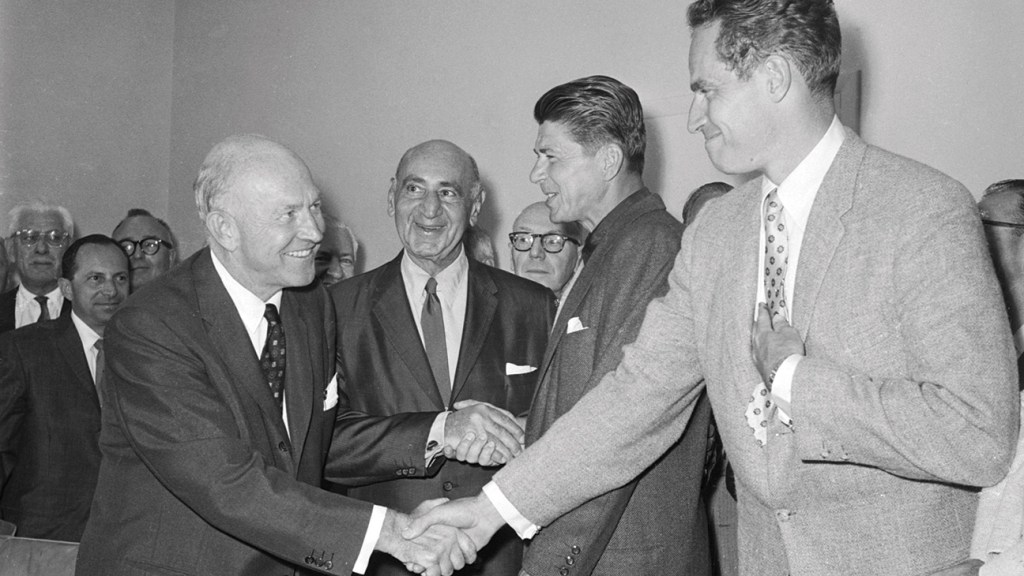
The “double strike” of 1960 — the last time the Writers Guild and SAG marched shoulder to shoulder in a labor action against the owners of the means of production and, crucially, distribution — is the clear precedent to the ongoing reboot. Yet while historians like to believe that the past is prologue, or at least a cautionary example, for all the parallels between the two walk-outs the differences are stark. Today, the tone is more rancorous, the stakes more serious.
The connecting thread is the upheaval wrought by a new communications technology. In 1960, the disrupter was TV; today, it’s digital streaming. In both instances, the new revenue source for the producers makes the old terms of service for the talent look like a pact with the devil. Then, as now, the artists seek a bigger slice of the pie, or crumbs really, parceled out in decimal points, from a cash flow unimagined when they signed the original deal. “To the guild[s], this is extra pay for extra use and perfectly proper,” observed the trade weekly Broadcasting in 1960 in an apt summary of the battle lines. To the producers, “this is double pay for the same job and completely improper.”
To read the sideline commentary during the 1960 strike (the writers walked out, or stopped typing, on Jan. 16 and settled on June 25; SAG struck on March 7 and agreed to settle a month later, on April 8) is to hear an unmistakable echo of current opinion. “The film business is on the brink of disaster, with every branch of the business having contributed to that condition,” warned Billy Wilkerson, then-owner of The Hollywood Reporter.
In 1960, however, the prospects for an expeditious settlement were facilitated by an adherence to a set of social norms not yet shattered by social media. Looking back, one is struck by the moderate tone and measured language from the representatives on both sides. John L. Dales, national executive secretary of SAG, criticized the “shortsighted, belligerent attitude” of the producers and chided them for giving the “impression that the guild proposals are new and revolutionary, whereas the truth is that these principles are well established and accepted,” but he didn’t resort to insult.
Charles S. Boren, the executive vp in charge of industrial relations for the Association of Motion Picture Producers (AMPP), the precursor to the AMPTP, made a point of speaking more in sorrow than anger. “We deeply regret the Screen Actors Guild action in calling a strike, thus imperiling thousands of jobs in the industry as well as the institutions of the industry,” he said, expressing hope that a prompt resumption of negotiations would “preserve the jobs of many innocent bystanders.” Sure, they were striking a pose, and behind closed doors things doubtless got testy, as arguments over money always do, but the language of diplomacy kept heads cool and relations congenial.
On April 8, when SAG and the AMPP announced a tentative agreement, SAG president Ronald Reagan and Charlton Heston, a member of the SAG negotiating committee, and Columbia vp B.B. Kahane and Boren shook hands for the cameras. The men are beaming, all smiles; you can imagine them all going out for a drink after. Throughout the negotiations, producers weren’t so callous as to publicly wish that the screenwriters be left destitute and homeless; no actor responded with 12-letter epithets.
Likewise, the rhetoric surrounding the 95-day strike by SAG in 1980 over wages and residuals for the new revenue stream of that day — pay television, videocassettes and video discs — was also almost demure, at least for attribution in print, compared to the unfiltered, hit-send sentiments provoked by today’s platforms (though actor Ed Asner, characteristically, was as blunt as newsprint would allow: “I think it stinks,” he said of the pact ultimately agreed to).
Unfortunately, the 2023 strikers confront a wholly new threat — namely, the ghost in the machine that Hollywood itself has been warning us about since 2001: A Space Odyssey, artificial intelligence, which judging by the proposals put on the table by the producers seems to have already achieved singularity in Hollywood. SAG-AFTRA president Fran Drescher was not being a Luddite when she warned that “we’ll all be replaced by machines,” but it might actually be worse than that. Automation can take your job; AI wants your soul. (The AMPTP’s July 21 characterization of its AI proposal was that it favors “a balanced approach based on careful use, not prohibition.”)
In this sense, the picketers are at the leading edge of a battle that the ranks of labor — indeed, the entire U.S. body politic — needs to attend to. The fight for a better residual contract is a matter of dollars and cents, a deal can be cut, differences can be split. The right to your own self is non-negotiable, what the Founding Fathers called “unalienable” — meaning a right so fundamental to what it means to be human that it cannot be “alienated” — that is, relinquished or surrendered.
You can sign away the rights to a single performance or a screenplay, but no matter how desperate for a gig, you cannot sign away your self. “We had faces,” says Norma Desmond in Sunset Blvd. “We want your faces now — and your voice and body” is what the talent fears the producers are saying. That’s not a bargaining chip; it’s a deal-breaker.
This story first appeared in the July 26 issue of The Hollywood Reporter magazine. Click here to subscribe.













